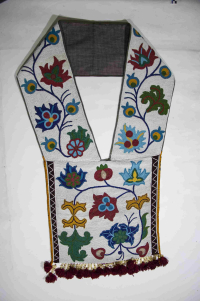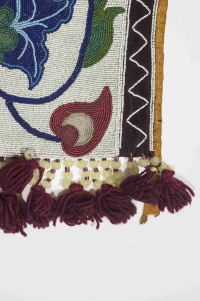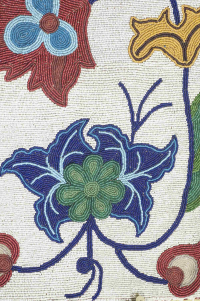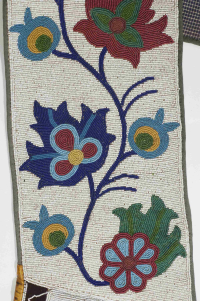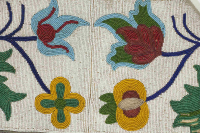Bandolier bag
Bandolier bag
Bandolier bag




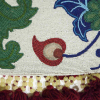











Overlaid spot stitch appliqué, multi-coloured floral seed bead design, bias tape & silk ribbon edging, tube beads & round plastic pony beads on red yarn tassels
from catalogue records
Summary of available information
Read More About This Relative
Fabric, cotton, checked (navy & white), Fabric, velveteen, brown (medium), Ribbon, silk, yellow (mustard), Bias tape, cotton, blue (slate), Yarn, red (garnet), Beads, pony, plastic, yellow (opaque light lemon), Beads, tubular, red (translucent garnet), Beads, seed, glass clear, white (opaque), brown (opaque chocolate), red (opaque scarlet, transparent garnet), yellow (opaque mustard, opaque yellow), green (opaque medium, opaque teal, transparent teal), blue (opaque sky, opaque medium blue, opaque navy).
Hand sewn, Lined with blue and white check cotton cloth, Strap edged with green bias tape, Panel edged with yellow silk ribbon which forms tabs at bottom corners.
Decorated with closed backed overlaid spot stitch appliqué, multi-coloured floral stem and leaf seed bead design in white field, floral, leaf, stem, three-petalled flower, four-petalled flower, seven-petalled flower, eight-petalled flower, berry?, trillium flower?, Maple leaf?, Heart?, Bordered with brown velveteen decorated with white beads in zigzag design and two lines vertical white beads, Fringe of forty paired strands red translucent faceted tube beads and round yellow pony beads tied with red yarn tassels.
Bandolier bags most likely originated in the Upper Great Lakes region during the 1840s and 1850s. Fashioned exclusively from European materials and adorned with thousands of beads, bandolier bags were primarily for show, as a symbol of identity, wealth and status. Although initially functional, by the late 19th and early 20th centuries many of the bags had false pockets or none at all. Sometimes called "friendship bags", they were often created as gifts to strengthen relationships within communities or between nations. By the 1870s they had become an important element of formal dress worn mainly at ceremonies and celebrations by men, and occasionally by women. They wore them - singly or several at a time - crossed over the torso or draped around the neck. “The wearing of more than one bag was generally the prerogative of a leader or a person of high honour." (McCord, 2013) “Bandoliers were adopted by Ojibwa in 19th century after seeing bullet pouches used by British soldiers. Bullet pouches were plain and decorated with crest or coat of arms. When idea adopted by Ojibwa, they were greatly prized and highly decorated ceremonial accessories. They became so highly prized by Ojibwa and other tribes (especially Sioux), that one bandolier could be traded for one pony. They became a status symbol of highest ranking Midewiwin priests. (Flanders, 1977)
Provenance
McCord Museum, Wearing Our Identity. Montreal: The McCord Museum, 2013; and “Beads: Their Use By Upper Great Lakes Indians” by Richard Flanders, 1977
McCord Museum. Wearing Our Identity. Montreal: The McCord Museum, 2013. Print.
About This GRASAC Record
Manitoba Museum
Content from the Manitoba Museum's catalog records. Uploaded by Orvis Starkweather as part of their summer internship.













Plains
 Knowledge Sharing Platform
Knowledge Sharing Platform

